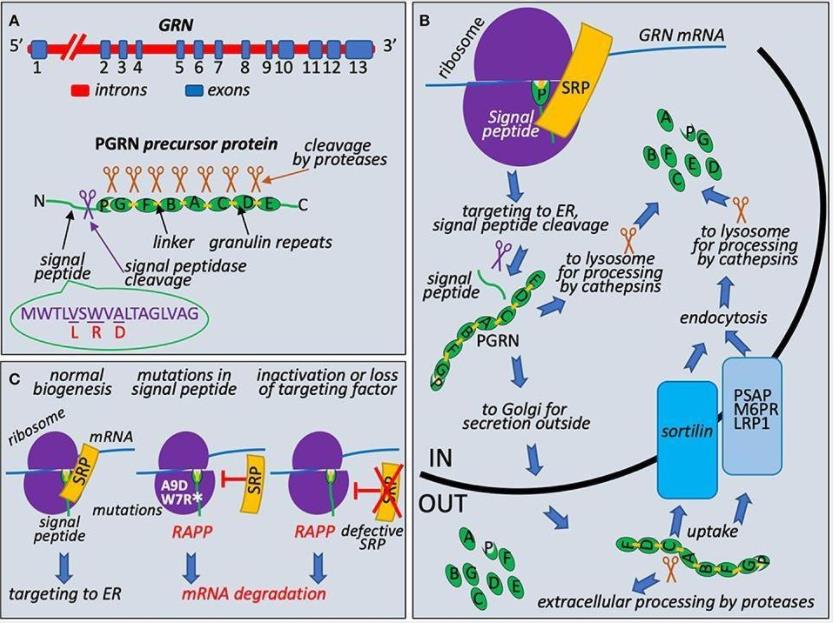What is GRN Protein
Each biological molecule plays a vital role in maintaining the delicate balance of life. Among them, the GRN (progranulin) protein plays a key role in coordinating various cellular processes.
What is GRN Protein?
GRN protein, encoded by the GRN gene located on chromosome 17, is a multifunctional player in cellular processes. Pregranulin (the precursor to GRN) is cleaved into smaller peptides. This protein is widely expressed in a variety of tissues, indicating its indispensable role in maintaining normal cellular functions.
 Figure 1. Granulin biogenesis, quality control at the ribosome during its synthesis, and molecular mechanism of FTLD associated with mutations in the signal peptide of the granulin precursor (Karamysheva, Z.N., et al. 2019)
Figure 1. Granulin biogenesis, quality control at the ribosome during its synthesis, and molecular mechanism of FTLD associated with mutations in the signal peptide of the granulin precursor (Karamysheva, Z.N., et al. 2019)The Function of GRN Protein
GRN emerges as an important regulator of cell growth and survival. GRN interacts with different receptors and signaling pathways to delicately balance cell proliferation and apoptosis. Its anti-inflammatory properties make GRN a modulator of immune responses, playing a key role in the response to infection and injury while preventing chronic inflammation.
Furthermore, GRN plays a crucial role in tissue repair and remodeling, contributing to the regeneration of damaged tissue. This multifaceted function makes the GRN indispensable in coordinating the body's response to injury and stress.
GRN-Related Diseases
GRN dysregulation is closely associated with neurodegenerative diseases, and GRN gene mutations are found in frontotemporal lobar degeneration (FTLD). In these cases, reduced functional GRN levels lead to neuronal degeneration, underscoring the critical role of GRN in neuroprotection.
In addition to neurodegeneration, abnormal GRN expression is associated with certain cancers, such as breast and ovarian cancer. Although the exact mechanism is still under investigation, this correlation suggests that GRN is involved in cancer progression, underscoring its importance as a potential therapeutic target.
GRN Related Signaling Pathways
The complex signaling pathways associated with GRN involve its interactions with cell surface receptors, particularly the tumor necrosis factor (TNF) receptor family. Binding to these receptors triggers intracellular events that regulate cell survival, inflammation, and other important processes. Continued exploration of these pathways is critical to identify therapeutic targets for diseases associated with GRN dysregulation.
Applications of GRN in Biomedical Research
- Neurodegenerative Disease Therapies
The versatile nature of GRN makes it a promising drug candidate for the treatment of neurodegenerative diseases, especially FTLD. Strategies focused on increasing GRN levels or enhancing its activity may slow or halt the progression of these debilitating diseases.
- Cancer Therapies
Understanding the role of GRNs in tumorigenesis opens avenues for targeted cancer therapy. Manipulating GRN expression or activity provides a potential therapeutic approach to specifically target cancer cells, proposing a new approach to cancer treatment with minimal impact on healthy tissue.
- Regenerative Medicine
GRN is involved in tissue repair and remodeling, making it a key player in the field of regenerative medicine. Exploiting its properties may lead to the development of therapies that accelerate wound healing, tissue regeneration and recovery from injury, thus providing a new dimension to the field of regenerative medicine.
The GRN protein serves as a molecular linchpin that are intricately integrated into the fabric of cellular processes. Its involvement in health and disease, coupled with its potential applications in biomedicine, has made the GRN a focus of scientific exploration and therapeutic innovation. As we unravel the complexities of GRN, we pave the way for breakthrough advances that hold great promise for the future of medicine.
Recommended Products for GRN Protein
| Cat.# | Species | Product name | Source (Host) | Tag |
|---|---|---|---|---|
| GRN-4937H | Human | Recombinant Human Mitogen-Activated Protein Kinase 11 | HEK293 | N/A |
| GRN-2379H | Human | Recombinant Human Granulin, FLAG-tagged | Human Cell | Flag |
| GRN-726H | Human | Recombinant Human GRN protein, His-tagged | HEK293 | His |
| GRN-2358H | Human | Recombinant Human GRN Protein, MYC/DDK-tagged | HEK293 | Myc/DDK |
| GRN-5599HF | Human | Recombinant Full Length Human GRN Protein, GST-tagged | In Vitro Cell Free System | GST |
| Grn-466M | Mouse | Active Recombinant Mouse Grn, FLAG-tagged | HEK293 | Flag |
| Grn-3287M | Mouse | Recombinant Mouse Grn protein, His-tagged | HEK293 | His |
| Grn-469R | Rat | Recombinant Rat Grn, FLAG-tagged | HEK293 | Flag |
| Grn-1593R | Rat | Recombinant Rat Grn Protein, His-tagged | E.coli | N-His |
Reference
- Karamysheva, Z.N., Tikhonova, E.B., Karamyshev, A.L. Granulin in Frontotemporal Lobar Degeneration: Molecular Mechanisms of the Disease. Front Neurosci. 2019, 13: 395.

